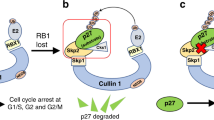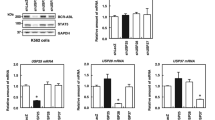Abstract
Cyclin D1 is an important regulator of the transition from G1 into S phase of the cell cycle. The level to which cyclin D1 accumulates is tightly regulated. One mechanism contributing to the control of cyclin D1 levels is the regulation of its ubiquitination. SK-UT-1B cells are deficient in the degradation of D-type cyclins. We show here that p27, a substrate of the SCFSkp2 ubiquitin ligase complex, is coordinately stabilized in SK-UT-1B cells. Further, we show that expression of Skp2 in SK-UT-1B cells rescues the cyclin D1 and p27 degradation defect observed in this cell line. These results therefore indicate that the SCFSkp2 ubiquitin ligase complex affects the ubiquitination of cyclin D1. In addition, we show that SK-UT-1B cells express a novel splice variant of Skp2 that localizes to the cytoplasm and that cyclin D1 ubiquitination takes place in the nucleus. We propose that the translocation of Skp2 into the nucleus is required for the ubiquitination of cyclin D1 and that the absence of the SCFSkp2 complex in the nucleus of SK-UT-1B cells is the mechanism underlying the ubiquitination defect observed in this cell line. Finally, our data indicates that differential splicing of F-box proteins may represent an additional level of regulation of the F-box mediated ubiquitination pathway.
This is a preview of subscription content, access via your institution
Access options
Subscribe to this journal
Receive 50 print issues and online access
$259.00 per year
only $5.18 per issue
Buy this article
- Purchase on Springer Link
- Instant access to full article PDF
Prices may be subject to local taxes which are calculated during checkout







Similar content being viewed by others

References
Amati B, Vlach J . 1999 Nature Cell. Biol. 1: E91–E93
Bai C, Sen P, Hofmann K, Ma L, Goebl M, Harper JW, Elledge SJ . 1996 Cell 86: 263–274
Bortner DM, Rosenberg MP . 1997 Mol. Cell. Biol. 17: 453–459
Bouchard C, Thieke K, Maier A, Saffrich R, Hanley-Hyde J, Ansorge W, Reed S, Sicinski P, Bartek J, Eilers M . 1999 EMBO J. 18: 5321–5333
Carrano AC, Eytan E, Hershko A, Pagano M . 1999 Nature Cell. Biol. 1: 193–199
Cheng M, Olivier P, Diehl JA, Fero M, Roussel M, Roberts JM, Sherr CJ . 1999 EMBO J. 18: 1571–1583
Dealy MJ, Nguyen KV, Lo J, Gstaiger M, Krek W, Elson D, Arbeit J, Kipreos ET, Johnson RS . 1999 Nature Genet. 23: 245–248
Demetrick DJ, Zhang H, Beach DH . 1996 Cytogenet Cell Genet. 73: 104–107
Deshaies RJ, Chau V, Kirschner M . 1995 EMBO J. 14: 303–312
Diehl JA, Cheng MG, Roussel MF, Sherr CJ . 1998 Genes Dev. 12: 3499–3511
Germain D, Russell A, Thompson A, Hendley J . 2000 J. Biol. Chem. 275: 12074–12079
Helin K . 1998 Curr. Opin. Gen. Dev. 8: 28–35
Krek W . 1998 Curr. Opin. Gen. Dev. 8: 36–42
LaBaer J, Garrett MD, Stevenson LF, Slingerland JM, Sandhu C, Chou HS, Fattaey A, Harlow E . 1997 Genes Dev. 11: 847–862
Lammie GA, Fantl V, Smith R, Schuuring E, Brookes S, Michalides R, Dickson C, Arnold A, Peters G . 1991 Oncogene 6: 439–444
Lebwohl DE, Muise-Helmericks R, Sepp-Lorenzino L, Serve S, Timaul M, Bol R, Borgen P, Rosen N . 1994 Oncogene 9: 1925–1929
Lisztwan J, Marti A, Sutterluty H, Gstaiger M, Wirbelauer C, Krek W . 1998 EMBO J. 17: 368–383
Lundberg AS, Weinberg RA . 1998 Mol. Cell. Biol. 18: 753–761
Marti A, Wirbelauer C, Scheffner M, Krek W . 1999 Nature Cell. Biol. 1: 14–19
Motokura T, Arnold A . 1993 Biochem. Biophys. Acta 1155: 63–78
Motokura T, Bloom T, Kim HG, Juppner H, Ruderman JV, Kronenberg HM, Arnold A . 1991 Nature 350: 512–515
Nakayama K, Nagahama H, Minamishima YA, Matsumoto M, Nakamichi I, Kitagawa K, Shirane M, Tsunematsu R, Tsukiyama T, Ishida N, Kitagawa M, Nakayama K, Hatakeyama S . 2000 EMBO J. 19: 2069–2081
Perez-Roger I, Kim SH, Griffiths B, Sewing A, Land H . 1999 EMBO J. 18: 5310–5320
Russell A, Thompson A, Hendley J, Trute J, Armes J, Germain D . 1999 Oncogene 18: 1983–1991
Schulman BA, Carrano AC, Jeffrey PD, Bowen Z, Kinnucan ER, Finnin MS, Elledge SJ, Harper JW, Pagano M, Pavletich NP . 2000 Nature 408: 381–386
Sherr CJ, Roberts JM . 1995 Genes Dev. 9: 1149–1163
Skowyra D, Craig KL, Tyers M, Elledge SJ, Harper JW . 1997 Cell 91: 209–219
Skowyra D, Koepp DM, Kamura T, Conrad MN, Conaway RC, Conaway JW, Elledge SJ, Harper JW . 1999 Science 284: 662–665
Sutterluty H, Chatelain E, Marti A, Wirbelauer C, Senften M, Muller U, Krek W . 1999 Nature Cell. Biol. 1: 207–214
Swanson C, Ross J, Jackson PK . 2000 Proc. Natl. Acad. Sci. USA 97: 7796–7801
Tsvetkov LM, Yeh KH, Lee SJ, Sun H, Zhang H . 1999 Curr. Biol. 9: 661–664
Tyers M, Willems AR . 1999 Science 284: 601, 603–604
Wang T, Cardiff RD, Zukerberg L, Lees E, Arnold A, Schmidt EV . 1994 Nature 369: 669–671
Wang Y, Penfold S, Tang X, Hattori N, Riley P, Harper JW, Cross JC, Tyers M . 1999 Curr. Biol. 9: 1191–1194
Weinberg RA . 1995 Cell 81: 323–330
Welcker M, Lukas J, Strauss M, Bartek J . 1996 Oncogene 13: 419–425
Wirbelauer C, Sutterluty H, Blondel M, Gstaiger M, Peter M, Reymond F, Krek W . 2000 EMBO J. 19: 5362–5375
Yu Z, Gervais JLM, Zhang H . 1998 Proc. Natl. Acad. Sci. USA 95: 11324–11329
Zhang H, Kobayashi R, Galaktionov K, Beach D . 1995 Cell 82: 915–925
Acknowledgements
We would like to thank Drs Matthew O'Connell, Patrick Humbert and Grant McArthur for critical reading of this manuscript and also Matthew Beasley for help with genomic structure analysis of Skp2. This work was supported by NHMRC grant no. 981080 and a Susan G Komen grant to D Germain.
Author information
Authors and Affiliations
Corresponding author
Rights and permissions
About this article
Cite this article
Ganiatsas, S., Dow, R., Thompson, A. et al. A splice variant of Skp2 is retained in the cytoplasm and fails to direct cyclin D1 ubiquitination in the uterine cancer cell line SK-UT. Oncogene 20, 3641–3650 (2001). https://doi.org/10.1038/sj.onc.1204501
Received:
Revised:
Accepted:
Published:
Issue Date:
DOI: https://doi.org/10.1038/sj.onc.1204501
Keywords
This article is cited by
-
Akt finds its new path to regulate cell cycle through modulating Skp2 activity and its destruction by APC/Cdh1
Cell Division (2009)
-
Over-expression of Skp2 is associated with resistance to preoperative doxorubicin-based chemotherapy in primary breast cancer
Breast Cancer Research (2008)
-
Expression of truncated Int6/eIF3e in mammary alveolar epithelium leads to persistent hyperplasia and tumorigenesis
Breast Cancer Research (2007)
-
The cyclin D1 proto-oncogene is sequestered in the cytoplasm of mammalian cancer cell lines
Molecular Cancer (2006)
-
Histone deacetylase inhibitor, Trichostatin A induces ubiquitin-dependent cyclin D1 degradation in MCF-7 breast cancer cells
Molecular Cancer (2006)


